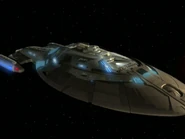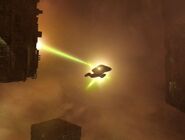AT: "xx"
The SC-4 with armor deployed
Ablative generators were an advanced armor technology used by Starfleet. Shield emitters generated a nearly-impenetrable layer of armor around the hull of a ship so equipped. This defensive technology was acquired by the crew of USS Voyager in 2378 from Admiral Kathryn Janeway of an alternate timeline. (VOY: "Endgame")
History
In the alternate timeline, ablative generators were developed as an anti-Borg technology by Captain Janeway. Invented some time after they encountered the transwarp hub hidden inside a nebula in 2378, but chose not to investigate it further. She used the technology to protect Voyager against the Borg on their voyage back to Earth. By 2404, ablative generators had not yet become standard equipment on Starfleet vessels. Ships like the USS Rhode Island were not equipped with them. Also, the Klingons did not yet possess ablative generators.
During that year, Admiral Janeway embarked on an illegal mission to change history by traveling back in time to help secure Voyager's safe return to the Alpha Quadrant sixteen years early. Janeway utilized a Starfleet Command shuttlecraft, the SC-4, equipped with ablative generators when meeting with Korath, a Klingon scientist, who had developed the chrono deflector, a device capable of generating temporal rifts for time travel. Janeway stole the chrono deflector and used the ablative armor to defend the shuttle against nadion discharges fired by Korath's Negh'Var-class warship in a retaliatory attack.
After successfully traveling back in time to 2378, Admiral Janeway assisted Voyager's crew in manufacturing and installing the advanced armor technology aboard the ship. The crew used the armor to defend themselves against Borg attacks while attempting to access the transwarp hub located in grid 986. When the Borg Queen assimilated Admiral Janeway, she also assimilated knowledge of how to construct the armor technology, but was killed by the neurolytic pathogen Janeway was infected with. Eventually Voyager's armor integrity was depleted down to to six percent by a pursuing Borg sphere and the crew had to allow the ship to be captured. They were, however, able to use transphasic torpedoes to destroy the sphere upon exiting the transwarp conduit near Earth. (VOY: "Endgame")
Background
After its critical role in "Endgame", the armor was not shown to be deployed on Federation starships in any subsequent Star Trek production, such as the USS Enterprise-E seen in Star Trek Nemesis or the Jellyfish in Star Trek. This armor technology should not be confused with the ablative armor that was already used on Borg spheres, the USS Defiant, and USS Prometheus starships.
According to Mr. Scott's Guide to the Enterprise (page 14), the deflector shields of the refit-Constitution-class were a similar technology, while only the defense fields protecting the top decks were traditional force fields. The main shield grid was a massive replicator system, projecting an invisible hull layer, molecularly identical to the diburnium-osmium alloy used to build the Kalandan outpost.
In fact, shield impacts from Klingon photon torpedoes were shown to hit the USS Enterprise-A at the armor plating level in Star Trek VI: The Undiscovered Country leaving some scorch marks from the detonation and small electric arcs, instead of impacting a "shield bubble" such as the shield effect had been established in Star Trek: The Next Generation, which was in production of season 5 at the time of the films release.
Apocrypha
The ablative generators were mentioned in the Star Trek: Destiny trilogy of novels: they were initially examined by Starfleet as a part of Project Full Circle but were abandoned as anti-Borg technology because the Borg Queen had assimilated this technology from Admiral Janeway.
The ablative generator technology appears on the Intrepid-class retrofit available to players of Star Trek Online.




